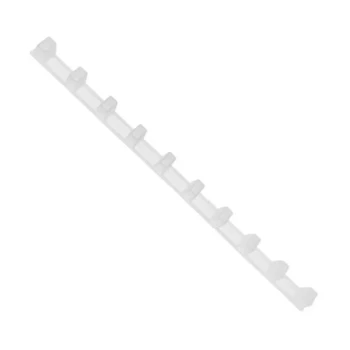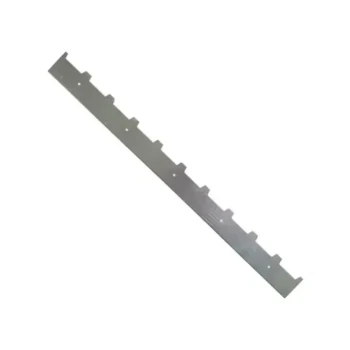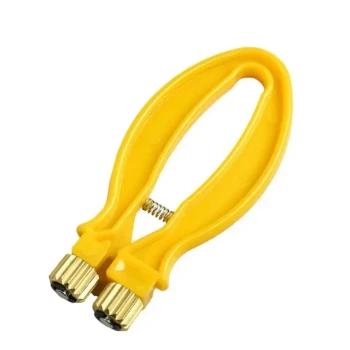In short, the spacing of frames in a nuc super is a deliberate management technique, not a uniform measurement. When introducing a new foundation frame, it is pressed tightly against an existing comb frame to encourage the bees to build straight, new comb. The remaining frames are then spaced out to maintain proper bee space for honey storage and movement.
Frame spacing in a nuc super is an active strategy to control where and how bees build comb. The goal is to manipulate the bees' natural instincts to ensure they draw new foundation correctly while preventing the creation of unwanted burr comb.
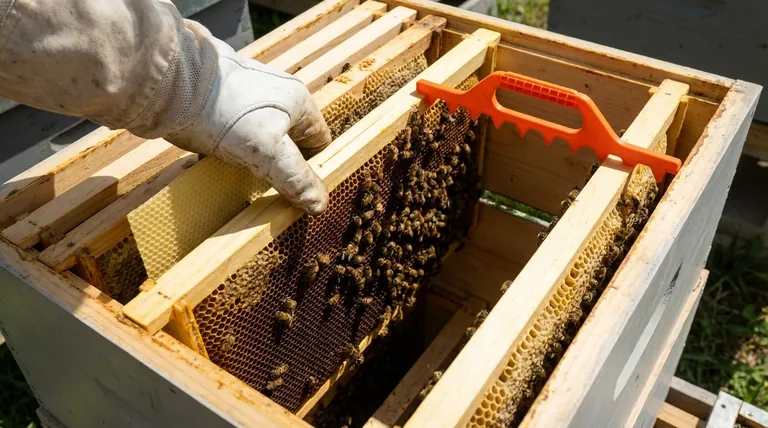
The Core Principle: Guiding Natural Instincts
To understand frame spacing, you must first understand the concept of "bee space." This is the fundamental principle that governs all modern hive design and management.
What is Bee Space?
Bee space is the specific gap, approximately 3/8 of an inch (9.5mm), that bees naturally leave between their combs. It's the perfect width for them to move and work back-to-back.
If a gap is larger than this, bees will fill it with extra, unwanted burr comb. If a gap is smaller, they will seal it shut with propolis, a resinous glue.
Why Manipulate Spacing?
A beekeeper actively manipulates frame spacing for one primary reason: to direct the colony's construction efforts.
By strategically tightening or standardizing the space between frames, you can encourage bees to draw out new foundation into perfect, straight comb and discourage them from building chaotically.
Standard Spacing Scenarios in a Nuc Super
The specific spacing strategy depends on what you are trying to accomplish, primarily whether you are adding new foundation for the bees to build on.
Scenario 1: Adding a Single Foundation Frame
When introducing one frame of new foundation, you want the bees to build on it quickly and correctly.
To achieve this, the foundation frame is squeezed tightly between the nuc wall and an adjacent frame of fully drawn comb.
This tight spacing leaves the bees no room to build problematic burr comb. Their only option is to build straight off the provided foundation, which is exactly the desired outcome. The other two comb frames are then spaced normally.
Scenario 2: Using Two Foundation Frames
If you need to add two new foundation frames at once, the strategy is slightly different.
In this case, a follower board is used. A follower board is essentially a thin, solid dummy frame that reduces the internal width of the super.
The foundation frames are placed together, and the follower board is used to press the entire set of frames tightly against one another and the hive wall. This creates a compact, controlled zone that forces the bees to focus their efforts on drawing out the foundation.
Understanding the Trade-offs
While manipulating frame spacing is a powerful technique, improper application can create problems. Understanding the potential downsides is key to effective management.
The Risk of Incorrect Spacing
If you place a new foundation frame with standard bee space on both sides, a strong colony may see the gaps as an opportunity.
They might build rogue burr comb between the frames instead of drawing out the foundation. This creates a mess that makes hive inspections difficult and can damage comb during removal.
The Follower Board: Benefits and Considerations
A follower board is an excellent tool for managing a small or growing colony, as it helps them thermoregulate a smaller space more efficiently.
However, it is another piece of equipment to manage. As the colony expands and fills the frames, the follower board must be removed to provide more space and prevent the colony from becoming honey-bound or deciding to swarm.
Making the Right Choice for Your Goal
Your spacing strategy should always be dictated by your immediate objective for the hive.
- If your primary focus is drawing new comb: Use tight spacing by pressing foundation frames directly against existing comb or by using a follower board.
- If your primary focus is honey storage in a strong hive: You can use standard, even spacing with frames that are already fully drawn with comb.
- If you are establishing a brand new nuc: Using a follower board is highly recommended to give the small colony a compact, manageable space to build out.
Ultimately, mastering frame spacing gives you direct control over your hive's development and productivity.
Summary Table:
| Scenario | Spacing Strategy | Primary Goal |
|---|---|---|
| Adding a Single Foundation Frame | Press foundation tightly against a drawn comb frame. | Encourage straight comb drawing. |
| Adding Two Foundation Frames | Use a follower board to tightly group all frames. | Force bees to focus on new foundation. |
| Strong Hive / Honey Storage | Use standard, even bee space (approx. 3/8 inch). | Maximize honey storage in drawn comb. |
Ready to master your hive management?
Proper frame spacing is essential for a productive apiary. At HONESTBEE, we supply commercial apiaries and beekeeping equipment distributors with the high-quality, durable supplies needed to implement these techniques effectively—from nuc boxes and frames to essential tools like follower boards.
Let our wholesale-focused expertise help your operation thrive. Contact our team today to discuss your equipment needs and boost your productivity!
Visual Guide
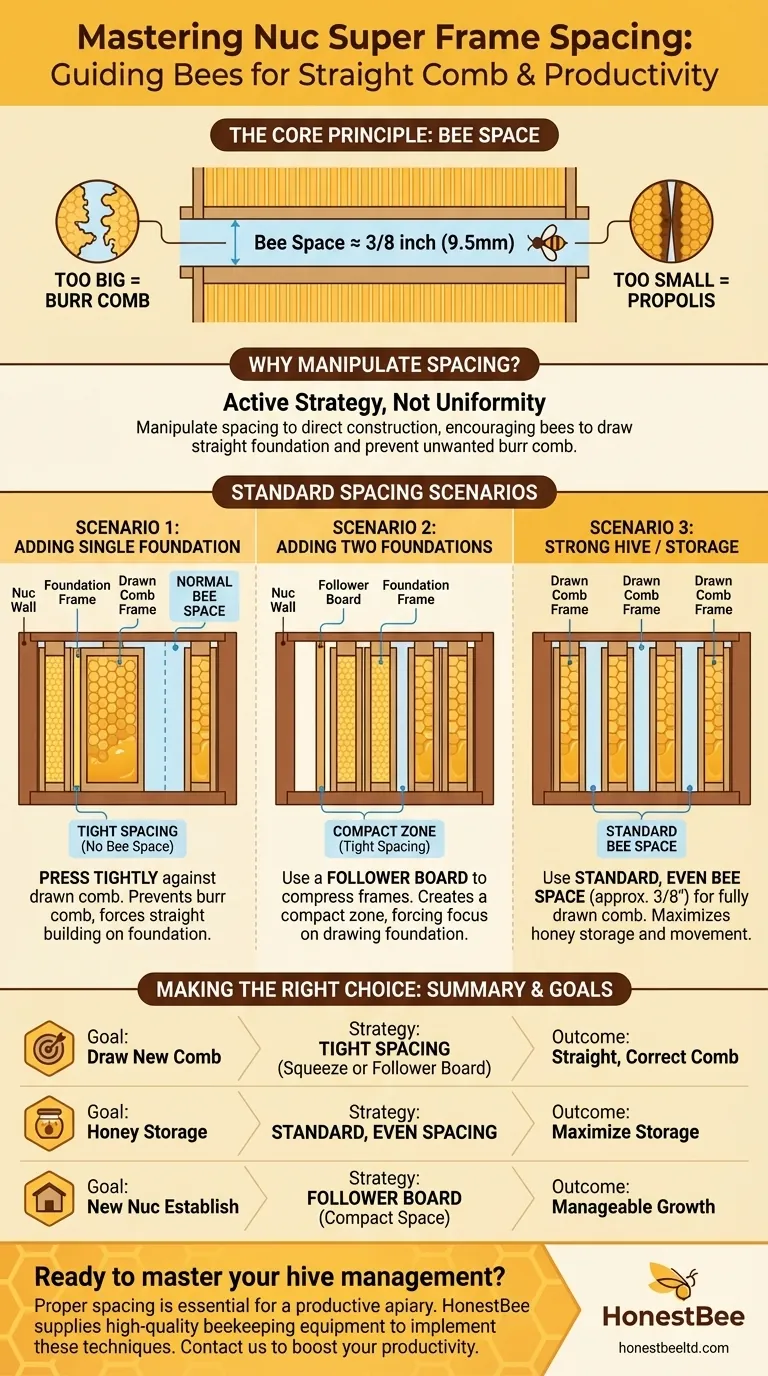
Related Products
- Ergonomic Plastic Frame Spacer Tool for Rapid Hive Management Beekeeping
- Durable Plastic Frame Spacer
- Stainless Steel 9 Frame Hive Spacer Durable Precise for Commercial Beekeeping
- Professional Castellated Iron Frame Spacer for Multiple Hive Types
- Professional 3-Bar Frame Grip with Integrated Hive Tool
People Also Ask
- What is 'bee space' and why is it important? The Key to Modern Beekeeping Success
- Why are my bees building combs between frames? Fix Cross Comb for Better Hive Management
- Why is it important to compress frames together in the center of the box after reassembly? Prevent Burr Comb and Hive Chaos
- Why use 9 frames in a 10 frame hive? Optimize Honey Harvesting with Strategic Spacing
- What is 'Bee Space' or 'Bee Passage' and why is it important in beekeeping? The Key to Modern Hive Management

